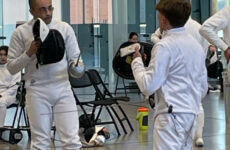Contrast and unity are two principles of design in art, and sometimes they coexist within the same piece. Artists have to achieve a balance between them in order to compose their works.
A recent assignment for my Art Appreciation class combined art and sociopolitical issues, both of which are decidedly subjective topics. In September, a London-based collective arrived at the Turner Prize show wearing shirts which boasted the message, “Black Pain Is Not For Profit,” according to an Art News article.
Their presence at the show was protesting “the utilisation of Black Death and Black pain by non-black artists and arts institutions for cultural and financial gain,” according to a message posted on the group’s Instagram. Specifically, they were objecting to artist Luke Willis Thompson’s work centered on racial violence, because they said he was exploiting the issue in interest of procuring a profit.
Reading about the protest roused my curiosity and left me with a lingering question: Can art be a form of hate speech?
It is a broad and multi-faceted inquiry; but nonetheless, worth breaking down and considering.
The collective, called BBZ London, posits Thompson used violence against minorities to his advantage because the controversial nature of the subject garnered significant publicity and thereby a profit for Thompson.
BBZ London noted how most of Thompson’s work showcases victims of police brutality or slavery, which in their opinion, glorifies acts that damaged their communities.
Lastly, the group thought Thompson was unscrupulous because he is “a white-passing male” creating the art; the article said Thompson is from a mixed-race family.
Racial discrepancies aside, I think the primary issue is where to draw the line between self-expression and hate speech. In other forms of communication, like spoken or written word, this distinction is more easily identified. Artwork however, is subjected to perceptions of both the artist and viewer, which blurs the line. Nonetheless I don’t believe anyone in the art community would deny that artists have a universal right to create and viewers a universal right to critique.
In Thompson’s case, he did not comment on the protest nor the meaning of his works, leaving much room for speculation. Without context from the artist, it is impossible to ascertain where their intentions may lie.
While I have never experienced discrimination due to my race nor truly understood what people who have go through, I feel a vital part of dissolving racial tensions is making attempts to empathize.
The truth behind Thompson’s artwork will likely never be fully known, and without knowing his perspective, there cannot be accurate criticism. More generally, however I don’t think an artist should be dismissed for utilizing their art in an attempt to understand another’s perspective. Perhaps work like this needs to be presented as a conversation starter between majority and minority groups. Rather than opposition and protest, maybe cooperation from both sides is a step toward resolution.
If cases arise where there is sufficient evidence, the issue of how to proceed and officially deem artwork “hateful” still remains. Realistically, artists could lie about their motivations in order to protect their public image and maintain their investors. Unfortunately, it would be a plausible scenario due to the intuitive nature of artwork. The art community would defend the artist’s freedom of expression through their work.
As art has evolved, it is more common for it to prompt controversy. However, we should not allow it to create division, there is already too much of that.
We have been fooled into thinking majority and minority groups are okay on their own. We aren’t, we need each other. So, instead of division, there needs to be transparency from artists and their critics, the majority and the minority. I believe an ongoing conversation between such groups can help secure freedom of expression as well as accurate representation.
This topic is diverse and certainly requires more examination. I think it would benefit from multiple perspectives, so if you wish to share your own thoughts in any way, I encourage you to email me at sabogaards@dmacc.edu.





Comments